In 2002, both the Kansas City Power and Light District and the Kauffman Center for the Performing Arts were still on the drawing boards when leaders of both organizations came together to discuss common interests in downtown development.
A bit later, Julia Irene Kauffman and new KCP&L Chairman Mike Chesser sealed a partnership that will shed light on performances in both Kauffman Center halls. KCP&L’s leadership believes, “The economic development potential of the Kauffman Center made it a strong charitable investment for the company.”
KCP&L has made a significant gift to the Kauffman Center’s capital campaign and has selected naming rights for, appropriately enough, a number of lighting features in both halls.
Their contribution supports concert lighting for the stage in the concert hall, performance lighting instruments in the proscenium theatre and a range of other critical equipment including followspots, canopy lighting and stage work lights. In addition, KCP&L’s Energy Solutions staff worked closely with Kauffman Center designers in planning energy components of the building.
In 2007, KCP&L formally became the signature sponsor for Downtown’s new entertainment district. Monies from the naming rights will be used to provide free community events and educational opportunities within the district. The KCP&L clock tower is already in place. The company has also placed an energy producing, helix-shaped wind turbine nearby with a colorful electronic LED display that lights up when energy is being produced by the turbine.
Investing in Downtown revitalization is an important part of KCP&L’s overall community strategy. Both the Kansas City Power & Light District and the Kauffman Center believe that people will be drawn to all the amenities, both before and after an arts event. In addition, they both contribute to workforce development and give area children a great place to experience the arts, two priorities for KCP&L’s charitable giving.
KCP&L was also interested in the Kauffman Center’s environmentally friendly features. The parking structure to the south will be covered by a “green roof”—literally. Landscaping above the garage not only provides a friendlier view, but reduces the effect of urban heat islands (that would be caused by surface lot parking). There is also a green roof north of the facility, at ground level, between the building and the street. A radiant heating and cooling system delivers heating and cooling only where it is needed and reduces the need for fan energy. Airside economizers allow outside air, when conditions permit, to naturally cool the interior zones.
“We are thrilled to have KCP&L support the Kauffman Center,” says Jane Chu, president and CEO of the performing arts center. “Their commitment to downtown is substantial and provides a great model for other businesses to follow.”
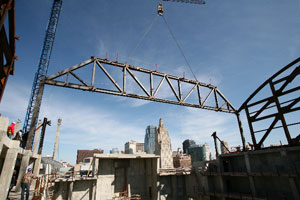 First Steel Truss is Installed
First Steel Truss is Installed
How do you get a 50-ton truss to the top of the Kauffman Center roof? With a really strong crane that can reach across the concrete base of the center and an experienced crew of steel installers carefully guiding it into place.
That’s why there’s a new crane in town. And it went to work on March 11, hoisting the first gigantic steel truss to the top of the Concert Hall. And while the center needs a roof for the obvious reasons, this part of the steel installation takes an important step toward completing the acoustic enclosure that will ensure great arts experiences.
The Kauffman Center construction site acquired a third large crane in early March. This bright red, white, and blue Demag 1800 is classified as a “600 ton crane” and was needed for several reasons.
“This crane has the ability to do “˜picks’ of 90 tons, which is required by the Kauffman Center specifications,” according to Kyle McQuiston, project executive for JE Dunn Construction. A “pick” refers to a load that is picked up, then maneuvered into place by the crane. “Plus this crane has the ability to reach out far enough, with that size load, to place the truss above the large concrete structure below,” McQuiston explains.
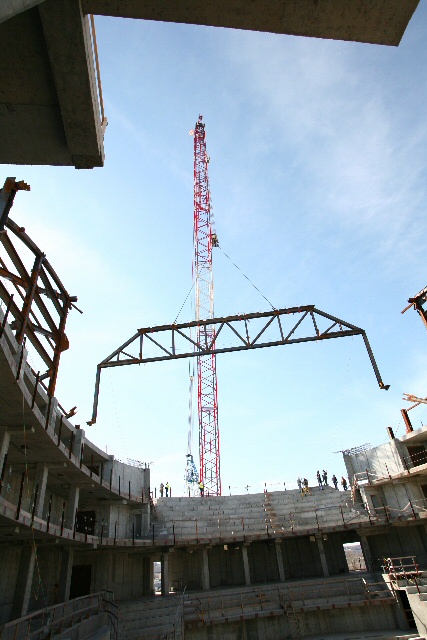 The first steel truss took just under an hour to lift into place above the Concert Hall. The trusses themselves are too large to be trucked in, so workers first must assemble and weld them together on site. The largest truss to be installed weighs 90 tons.
The first steel truss took just under an hour to lift into place above the Concert Hall. The trusses themselves are too large to be trucked in, so workers first must assemble and weld them together on site. The largest truss to be installed weighs 90 tons.
In order to reach everywhere that this crane’s special capacities are required, it will be moved three times during this phase of steel installation (to both the south and north sides of each hall). The two tower cranes currently on site cannot handle loads of this magnitude, but are required to assist the large mobile crane with connection pieces.
This new crane arrived with its own operator and will be on site for several months. “The project has the most detailed hoisting plan I’ve seen in 25 years of construction projects,” says McQuiston, as he points to a very large document on his desk. In addition, moving the crane is a major project, taking a week to ten days, as the crane must be dismantled in order to be relocated.
Construction rubberneckers on the street downtown will have a great time watching this crane do its work if the hoisting of the first truss is any indication. Even seasoned construction workers on site took time to watch the crane gingerly and precisely place tons of steel up on the roof.
- View the latest construction photos.
- Read more about the steel installation.
 For the last 10 years, Kansas City patrons have become accustomed to enjoying opera in its original language, aided by supertitle translations of lyrics and dialogue projected above the stage at the Lyric Theatre.
For the last 10 years, Kansas City patrons have become accustomed to enjoying opera in its original language, aided by supertitle translations of lyrics and dialogue projected above the stage at the Lyric Theatre.
At the Kauffman Center, audiences will have an even more personalized way to enjoy opera through an advanced titling system now being used in many theaters around the country. Each patron can choose to see the titles right at their seat. Or not. How’s that possible? “Figaro! Figaro!”
Figaro’s Simultext ® is an innovation that came about over margaritas at Maria’s in Sante Fe. The accompanying conversation was about how to make performances more accessible for patrons who had difficulty hearing at the Sante Fe Opera.
Afterwards, founder Patrick Markle worked with two other opera professionals to devise the first prototype of a personal device that takes titles directly to patrons’ seats. They soon saw that it had benefits for all theater-goers. “We think of it as a dashboard for the arts and more,” Markle says.
As a result, the Kauffman Center’s Proscenium Theatre will be outfitted with small screens behind each seat that provide the ultimate in personal choice. Markle likes to say that, with Figaro Simultext ®, “Titles are put in their place — where each patron can see them if they want and when they want.”
Similar systems are currently in use at the Seattle Opera House, the New York Metropolitan Opera, Sante Fe Opera, London’s Royal Opera House, the Vienna State Opera and the Grand Teatro del Liceu in Barcelona, Spain.
The system can deliver the words sung or spoken by single or multiple performers, three lines of text to each screen. Patrons decide if they want to see the titles and then they select the language of their choice. If they choose not to see titles, they simply touch the “off button” on their individual screen.
“The Figaro System has many advantages for our patrons,” says Ward Holmquist, musical director for the Kansas City Lyric Opera. “There will be no more “˜blind spots’ where titles can’t be read. Plus, audience members close to the stage will no longer have to crane their necks to see the titles.”
The Ballet could use the system to provide scene synopses. A lecturer speaking in Russian could be translated for the audience — in up to six languages. A theatre company could provide programming notes, casting changes or welcome a particular group of ticket holders.
Each screen is ergonomically placed just below the audience member’s view of the stage, well within a comfortable viewing angle. Importantly, each unit has a “privacy screen” so that they do not interfere with a neighbor’s enjoyment of what’s on stage.
In addition, the screens have soft lighting, not a TV-like glare. The OLED screens (organic light emitting diodes) display clear text in six languages and can fade fully, meaning that they do not constantly glow (like an LCD screen does). Plus, they are ultra-low in energy consumption.
“We’re grateful that a number of donors helped us to make Figaro available for Kansas City audiences,” says Jane Chu, President and CEO of the Kauffman Center. “It’s just one more way to assure that future performing arts experiences will be exceptional and available for everyone.”
Learn more about the Proscenium Theatre. Read theater designer Richard Pilbrow’s thoughts on a range of theatre design details.
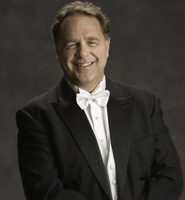 It shouldn’t be surprising that Artistic Director Ward Holmquist has grand plans for the Lyric Opera of Kansas City as he thinks about moving to the Kauffman Center for the Performing Arts. When asked what will change, Holmquist is only half-joking when he says, "Everything."
It shouldn’t be surprising that Artistic Director Ward Holmquist has grand plans for the Lyric Opera of Kansas City as he thinks about moving to the Kauffman Center for the Performing Arts. When asked what will change, Holmquist is only half-joking when he says, "Everything."
Then he explains how exciting that thought is for him and for the Lyric Opera family. "The community is taking an exponential leap forward and the way this project is being conceived and executed, we are going to have one of the world’s great live classical performance facilities. Some cities never have this opportunity." Holmquist feels that the Kauffman Center will affect the Lyric Opera in three main ways.
First, Holmquist says, the Company will be at the same production level and have the same equipment as the world’s best opera houses. "Ours may not be as big as, say the Met’s, but the Kauffman Center is being built with the active consultation of the leaders in the industry — acoustics, design, technical requirements, theater design,” Holmquist says. "Absolutely everything is being tended to by some of the best people in the profession. Once I became aware of that, it gave me a great deal of confidence in how the project would end up."
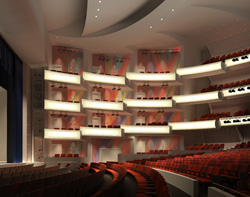 Second is the positive effect the Kauffman Center will have on the audience experience. "The Kauffman Center is designed to eliminate every obstacle to enjoying a live performance, except the energy it requires to get out of your chair. It will provide an exciting, social experience," Holmquist said. According to Holmquist, audiences will be pampered from ticket purchase, to easy parking and drop-off. "Plus we’ll have comfortable seating, great acoustics and an optimal place to enjoy our art form. It’s a dream-come-true for our patrons."
Second is the positive effect the Kauffman Center will have on the audience experience. "The Kauffman Center is designed to eliminate every obstacle to enjoying a live performance, except the energy it requires to get out of your chair. It will provide an exciting, social experience," Holmquist said. According to Holmquist, audiences will be pampered from ticket purchase, to easy parking and drop-off. "Plus we’ll have comfortable seating, great acoustics and an optimal place to enjoy our art form. It’s a dream-come-true for our patrons."
Third on Ward’s list is the fact that Kauffman Center’s proscenium theatre will expand programming possibilities for the Company. Holmquist points out that, in grand opera, there is a focus on opulent, impressive scenery. Wagner operas are not possible on the Lyric Theatre stage, because of space limitations but the Kauffman Center opens many new opportunities.
"We did an avant garde production of Verde’s Aida, which is grand opera," Holmquist says. "However we barely had enough room for the choristers on stage for the triumphal scene." Plus, the production required a large rock — but only in one scene. The rock was built, but was too big for the door and couldn’t be removed. "So we ended up staging the entire production around this ‘rock,’" Holmquist laughs. "The flexibility of our production team is amazing, but it will be so exciting to have possibilities to work with at the Kauffman Center, instead of limitations to work around."
Holmquist says he’s thrilled to be working with opera and its varied cultural influences — particularly now. "I am privileged to be around during a time when all of this is happening in Kansas City and I look forward to the change it will bring. The Kauffman Center will lift us artistically, through the new space, the facilities and the improved audience experience."
More details are available on the proscenium theatre:
- A conversation with Richard Pilbrow of Theatre Project Consultants
- An article about the stage tower and its many features.
- An explanation of the trap platform system beneath the stage floor.
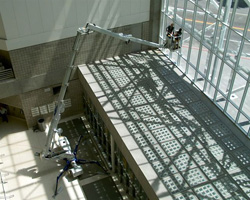 Ask Jane Chu what common questions she gets about the Kauffman Center and she’ll tell you that “How are you going to clean all that glass?” tops the list.
Ask Jane Chu what common questions she gets about the Kauffman Center and she’ll tell you that “How are you going to clean all that glass?” tops the list.
Fortunately the answer to that question has just become clearer because of a $250,000 gift from the Victor E. and Caroline E. Schutte Foundation. “The Schutte trustees told us upfront that they were willing to consider a need that is essential but not necessarily evident to others,” said Jane Chu, president and CEO of the Kauffman Center. “We immediately began exploring their interest in helping us to acquire vital window-washing equipment.”
The resulting grant will purchase a mechanical lift that allows workers to easily and safely reach the 95 foot heights — and all the nooks and crannies — of the impressive glass lobby. The lift must flex to fit through the center’s doorways and meet specifications for use on high quality, low-load floors. Both Victor Schutte and his wife Caroline worked in the family business, Schutte Lumber Company, which was founded in 1880. Over the years they accumulated considerable company stock which they used to found the Victor E. and Caroline E. Schutte Foundation. The foundation’s priorities focus on health care and women in business (as Caroline led the company for 30 years after her husband’s death).
“While the arts are a bit outside of our usual areas of focus, we saw the Kauffman Center as a real game-changer for our community and decided that the Schutte Foundation wanted to be part of this project,” co-trustee David Frantze explains. Frantze, an attorney at Stinson Morrison Hecker discussed the issue with co- trustee Spence Heddens of Bank of America, who agreed that the Schutte Foundation should find a way to support the Kauffman Center. “When Jane suggested the window-washing equipment, it made a lot of sense. We knew that this equipment is essential for a mostly-glass building that will become an iconic part of the Kansas City landscape,” Frantze said. Both trustees felt that this type of practical project would have appealed to the Schuttes, whose company provided resources like lumber for many of Kansas City’s projects over the last century.
“We often tell donors that they are helping us to reach new heights for the performing arts in Kansas City,” Jane Chu explains. “In the case of the Schutte Foundation gift, that remark can be taken literally.”
Read more about special features of the Grand Lobby.